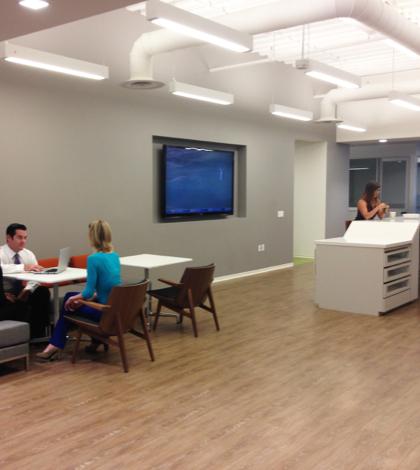No more conventional conference rooms or assigned work spaces, either, as the real estate brokerage shifts to a concept called Workplace360. The idea is to get workers to interact more, but to do that they must forego all personal space.
Joe Cesta no longer has an office, corner or otherwise, at CBRE Group Inc.’s Inland Empire headquarters.
He doesn’t even have an assigned desk or workspace.
Not to worry, though. Cesta is still CBRE’s managing director in the two-county region. It’s the office itself, at 4141 Inland Empire Blvd. in Ontario, that has undergone a radical transformation, one modeled on changes made last year to the company’s global headquarters in downtown Los Angeles.
The change is called Workplace360, a radical departure from a conventional office environment and one that CBRE is undertaking in about 15 of its offices worldwide. Lew Horne, the head of CBRE’s operations in Los Angeles and Orange counties, decided to try the idea in Los Angeles after touring CBRE’s offices in Amsterdam.
Gone are offices for executives, cubicles for the worker ants and traditional conference rooms. Gone also are file cabinets, most paper and all desktop computers.
In their place are work stations with desks that can be adjusted for sitting or standing, “huddle rooms” for impromptu conferences of up to six people and “focus rooms” for cold calling. The latter are equipped with thick glass doors and have special fabric on the walls that block out all sound.
There’s even a small room where employees can close the door, shut off the lights and clear their minds in total privacy. Employees are even allowed to take a nap if they feel like it will do them good.
Framed pictures of family members are also out. In their place, employees are given flash drives they can use to display personal photos on their laptop screens.
From the time the new office layout was announced, Cesta made it clear that the plan applied to everyone, no exceptions.
“There was some resistance at first, which we expected,” Cesta said. “Some people don’t like change, and this was a pretty big change. But everyone seems to be adjusting.”
The staff at CBRE Ontario moved into their new office June 30 after spending nine months in temporary space in the Inland Empire Boulevard building, longtime home of the company’s Inland Empire headquarters.
CBRE officials won’t say how much the new office cost, but they do expect to save about 10 percent during their 10-year lease compared with what they would have paid under the old arrangement.
That’s because the new facility has already achieved one of its major goals: saving space. The Inland Empire staff used to occupy 21,300 square feet on two floors; now it occupies 15,000 square feet on the building’s first floor.
Ninety two people work there now, and there’s room to accommodate about 25 more, Cesta said.
A second goal of Workplace360 – a paperless office – might not be realistic.
“I don’t know that we could ever get to a paperless office because in real estate you have so many documents,” Cesta said. “We told people to keep what they thought they needed, and we filled 17 dumpsters with paper, all of which was recycled. That’s a lot of paper.”
Companies have been experimenting for years with their work environments, trying to reconfigure things to make their workers more productive. In 1999, CCIM Institute in Chicago, which trains and certifies commercial real estate professionals, published an article that listed 10 trends in office design.
Those designs include an end to large offices, the introduction of shared private enclaves and “touchdown spaces” for e-mail, voice mail and basic filing.
The article noted that workers don’t have to be in one place all day to get their work done. Better that they walk around, exchange information and a get a feel for what projects other people are working, rather than be chained to a desk for eight hours.
That’s the atmosphere – generally more relaxed and collaborative than a conventional office environment – that Workplace360 is designed to create, although the concept has been quicker to catch on in Europe than in the United States.
Cesta said he knows of several local law firms that are trying concepts similar to Workplace360, but that he knows of no other real estate brokerages that are moving in that direction, at least for now.
“It’s a pretty strong departure from the conventional office,” said Cesta, who oversees all of CBRE’s activities in Riverside and San Bernardino counties. “The idea is to get people interacting with each other,” Cesta said. “If you can’t interact with other people then you probably don’t belong in real estate.”
Some consultants call the design an “address free” office because everyone has to relinquish their personal space.
At CBRE Ontario, no one has an assigned desk. When workers arrive in the morning they pick up their telephone headsets, laptops and the files they need from their locker, then grab whatever work station is available.
The only restriction is that workers go to their assigned neighborhoods: commercial, residential, retail, etc. All work stations have keyboards,
monitors and telephones that employees plug into when they arrive.
When people go home at night, they leave their items in their locker or take them home. When they return the next morning, they start fresh.
“The more I use it, the more I like it,” said John Oien, first vice president with CBRE. “I have five or six people within sight at all times, and I’ve come to like that.”
For one broker, the transition has been smoother than expected.
“I was a little reluctant at first – I think a lot of people were – but after awhile you realize this is a much more efficient system,” said Ryan Athens, a
vice president who specializes in industrial transactions. “You don’t isolate yourself, so you see and hear a lot more and you know what other people are doing. I also think it allows you to get better use of modern technology.”
 IE Business Daily Business news for the Inland Empire.
IE Business Daily Business news for the Inland Empire.


